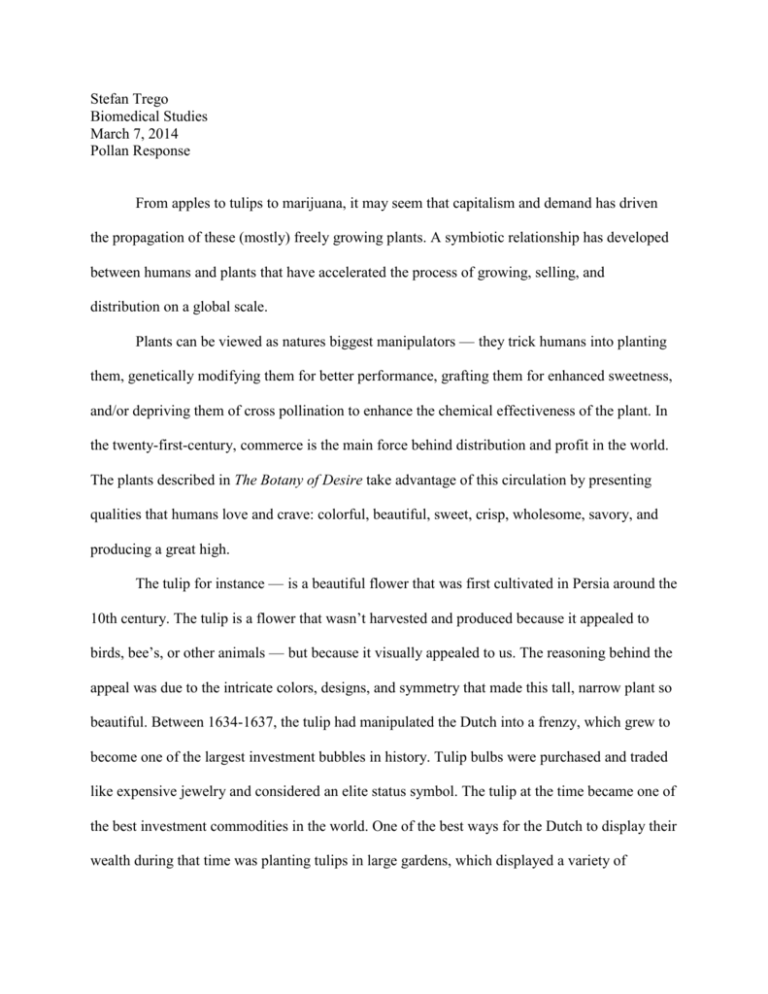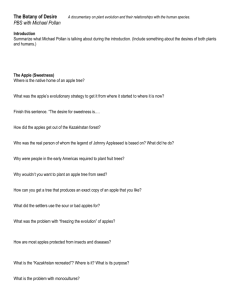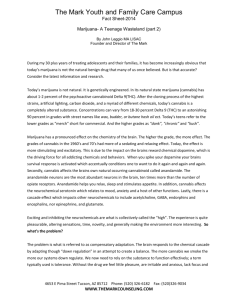Pollan Reponse
advertisement

Stefan Trego Biomedical Studies March 7, 2014 Pollan Response From apples to tulips to marijuana, it may seem that capitalism and demand has driven the propagation of these (mostly) freely growing plants. A symbiotic relationship has developed between humans and plants that have accelerated the process of growing, selling, and distribution on a global scale. Plants can be viewed as natures biggest manipulators — they trick humans into planting them, genetically modifying them for better performance, grafting them for enhanced sweetness, and/or depriving them of cross pollination to enhance the chemical effectiveness of the plant. In the twenty-first-century, commerce is the main force behind distribution and profit in the world. The plants described in The Botany of Desire take advantage of this circulation by presenting qualities that humans love and crave: colorful, beautiful, sweet, crisp, wholesome, savory, and producing a great high. The tulip for instance — is a beautiful flower that was first cultivated in Persia around the 10th century. The tulip is a flower that wasn’t harvested and produced because it appealed to birds, bee’s, or other animals — but because it visually appealed to us. The reasoning behind the appeal was due to the intricate colors, designs, and symmetry that made this tall, narrow plant so beautiful. Between 1634-1637, the tulip had manipulated the Dutch into a frenzy, which grew to become one of the largest investment bubbles in history. Tulip bulbs were purchased and traded like expensive jewelry and considered an elite status symbol. The tulip at the time became one of the best investment commodities in the world. One of the best ways for the Dutch to display their wealth during that time was planting tulips in large gardens, which displayed a variety of intricate colors and patterns. Fast forwarding to the 21st century, the Dutch are still in love with the tulip and it is still a money driven product which is grown on land-plots at an incredible scale to fuel the worlds demand. Distribution of these plants must also be executed very quickly. Once a tulip has been cultivated, it will lose fifteen-percent of its value by the next day. The process of harvesting tulips, storing them temporarily, and rapidly shipping them to customers within a short time for a plant that has no practical value requires a lot of human energy. This is especially impressive for a plant that has such a short expiration date and has no practical value other than being aesthetically beautiful to the eye. Cannabis, also known as marijuana, is a plant that has no beautiful flower, sweet or savory taste, or wholesome benefit. Its main purpose is inducing intoxication by altering the chemicals in the brain. Continuing the manipulation of humans, the cannabis plant has convinced humans to plant and distribute itself all around the world for the evolutionary characteristic of providing an altered consciousness that is obtained by smoking or ingesting the plant. Like the tulip, commerce is a large component driving the sale and consumption of cannabis — conversely, it is also illegal. Recently, a number of states have made the use of medical marijuana legal that includes: Alaska, Arizona, California, Colorado, Connecticut, Delaware, Hawaii, Illinois, Maine, Massachusetts, Michigan, Montana, Nevada, New Hampshire, New Jersey, New Mexico, Oregon, Rhode Island, Vermont, Washington, and even Washington D.C.. Only two-states have legalized recreational use of Marijuana: Washington and Colorado. Due to the stringent laws facing those who grow and consume marijuana, over 740,000 individuals are arrested for cannabis consumption, which costs taxpayers an estimated $10 billion annually. The function of cannabis in societies was not only recreational, but also medicinal, and used in applications such as: reducing pain, reducing nausea that arises from chemotherapy, and easing muscle spasticity. Marijuana production has developed into a global enterprise that requires a vast amount of human energy. Because marijuana is a global industry, the market is lucrative — economists, reformists, law enforcement, and the pro-marijuana lobby have calculated global sales from marijuana range from $10 billion to $120 billion annually. These are huge numbers for a plant that has no nutritional or practical value. Like the tulip, cannabis has developed a way to entice humans into growing at a global scale, spurring controversy, and inducing an altered state of mind. The apple is a fruit that isn’t harvested for a beautiful flower or mind-altering chemical, but for its sweet, crisp, and wholesome satisfaction. The apple got its start in America from John Chapman, better known as Jonny Appleseed, an early entrepreneur when it came to growing apples commercially. Johnny Appleseed traveled through the Ohio River Valley, planting and selling apple trees to settlers. According to Pollan, “Johnny Appleseed likened himself to a bee — like a bee, was spreading these plants around.” He was a very forward thinking individual that, in anticipation of locating an area that expected incoming settlers, would clear a section of land and set-up a nursery of apple tree saplings. By the time settlers arrived he would have saplings to sell to the settlers for a few cents a piece — this became a very lucrative business model for Johnny. As apples became more mature, they started to become developed for hard cider. Hard cider, a form of alcoholic beverage, can also elicit changes in brain function similar to cannabis. Cider was heavily consumed by early pioneers and into the 1800s. By the 1830s, cider became consumed so heavily that it evolved into a drink that was vilified much like cannabis in the 1960s. Even though sour-types of apples produced an acidity that was processed specifically for cider — there was a sweeter side of the apple that was still consumed for food. As the sweet apple evolved it became rebranded as a wholesome food — “an apple a day keeps the doctor away.” During the 1960s, the apple developed into a smaller subset that could be found in grocery stores across America. This vacuum of a market made it commercially easier for marketers of the apple and created a monoculture that produced a small amount of genetic varieties that adversely turned the apples into an easier target for pests. Shifting away from the monoculture production model, walk into any Wegmans grocery store and you’ll see that the current customer has access to Empires, Granny Smith, Gala, Fuji, Honeycrisp, Red Delicious, Pink Lady, Golden Delicious, Acey Macs, SweeTangos, Braeburns, Crispins, Macouns, Rainers, and Jonagolds, just to name a few. This essential biodiversity of sweet, edible apples has given the fruit genetic fruition. There are endless varieties of apples that are being produced for consumption, cider, ingredients, and other edible forms. From a commercial standpoint, this is incredibly valuable to the apple-farming infrastructure. Like the tulip and marijuana, apples are being purchased and distributed worldwide. According to the World Apple and Pear Association, as of 2012, the United States has imported 183,453 tons of apples. On a global scale, the total imports of apples exceeded 8 million tons of apples. Like tulips and cannabis, apples are also heavily valued and internationally distributed. In contrast to cannabis and tulips, they are incredibly practical and a building block to a healthy diet. According to Michael Pollan, “In the end, the logic of nature will win out over the logic of capitalism, the logic of the factory, and the logic of efficiency. It has always been so, and it will always be so. Nature is stronger than any of our designs and nature will always resist our control.” From the incredible popularity of the beautiful symmetric tulip, the addictive controversial cannabis plant, to the sweet-sour acidic apple — it’s truly amazing to ponder the expansion of a plant that may have been isolated to a specific region but instead, drastically globalized and became the fibers of commerce. Legal or illegal, plants will always manipulate humans and resist their control in every step of the way. Works Cited "20 Legal Medical Marijuana States and DC - Medical Marijuana - ProCon.org." ProConorg Headlines. N.p., 10 Mar. 2014. Web. 9 Mar. 2014. <http://medicalmarijuana.procon.org/view.resource.php?resourceID=000881>. "NORML.org - Working to Reform Marijuana Laws." About Marijuana. N.p., 9 Mar. 2014. Web. 10 Mar. 2014. <http://norml.org/marijuana>. "State Marijuana Laws Map." State Marijuana Laws Map. N.p., 9 Mar. 2014. Web. 10 Mar. 2014. <http://www.governing.com/gov-data/state-marijuana-laws-map-medicalrecreational.html>. "THE WORLD APPLE AND PEAR ASSOCIATION." WAPA. N.p., 9 Mar. 2014. Web. 10 Mar. 2014. <http://www.wapa-association.org/asp/index.asp>.









